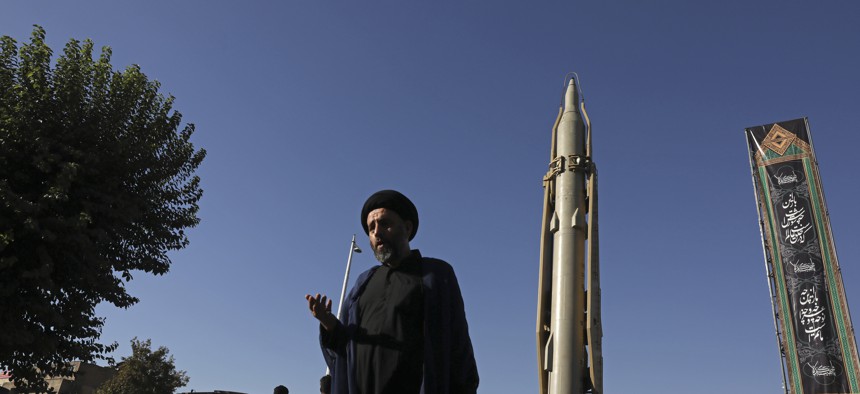
A Muslim cleric walks in downtown Tehran, where a Shahab-3 surface-to-surface missile is on display on Sept. 25, 2019. AP/Vahid Salemi
Iran Launched Missiles at Iraqi Bases with US Forces, Pentagon Says
More than a dozen ballistic missiles were fired at the Al-Assad air base in Anbar province and a base in Irbil, in Iraqi Kurdistan, a DOD statement said.
(Updated at 9:53 p.m. EST) Iran has launched more than a dozen ballistic missiles at two Iraqi military bases where U.S. personnel are based, according to reports from the region and confirmed by the Defense Department on Tuesday night.
The missiles were aimed at the Al-Assad air base in Anbar province and at a base in Irbil, in Iraqi Kurdistan. It was not immediately clear whether there were any casualties.
At 7:45 p.m., the Pentagon’s top spokesman issued a statement that defense officials are working on initial battle damage assessments, but that they had anticipated attacks on these two particular bases.
“These bases have been on high alert due to indications that the Iranian regime planned to attack our forces and interests in the region,” Jonathan Hoffman said in the statement. “As we evaluate the situation and our response, we will take all necessary measures to protect and defend U.S. personnel, partners, and allies in the region.”
At 9:45 p.m., President Trump tweeted, “All is well! Missiles launched from Iran at two military bases located in Iraq. Assessment of casualties & damages taking place now. So far, so good!”
U.S. officials have been poised for a retaliatory attack from Iran in the wake of the Jan. 2 targeted killing of Iran’s Gen. Qasem Soleimani last week, which critics worry could ignite a broader conflict with Iran. Senior Trump administration officials have insisted that killing Soleimani was intended to “deescalate” tensions.
Still, Defense Secretary Mark Esper said earlier on Tuesday that the United States expected some kind of retaliation from Iran.
“We should expect they will retaliate in some way shape or form,” Esper told reporters at the Pentagon, adding, “We are not looking to start a war with Iran, but we are prepared to finish one.”
The Iranian Revolutionary Guard Corps, or IRGC, quickly claimed responsibility for Tuesday’s missile attacks. Just after 9:30 p.m., Iranian Foreign Minister Javad Zarif added his own statement: "Iran took & concluded proportionate measures in self-defense under Article 51 of UN Charter targeting base from which cowardly armed attack against our citizens & senior officials were launched. We do not seek escalation or war, but will defend ourselves against any aggression."That represents a big change from the norm. In recent decades, Iran has typically used proxy forces to strike out at the United States. That Tehran, as a nation-state, launched military action directly against U.S. forces signals the seriousness of the strike. (The Trump administration designated the IRGC a terrorist organization last year, a move some experts said would be counterproductive.)
The Al-Assad base is about 230 miles (370 km) from the Iranian border, Irbil about 65 miles (105 km). That puts the former in range of about a half dozen of Iran’s operational types of short- and medium-range ballistic missiles, the latter within range of about three more, according to the Missile Defense Project of the Center for Strategic and International Studies in Washington.
Iran has invested heavily in its ballistic and cruise missile programs, which have produced more than a dozen operational types and has an estimated four more in development. It has been testing them in conflicts in Yemen and elsewhere, said Tom Karako, who leads the Missile Defense Project.
In June 2017, Iran fired ballistic missiles over Iraq into Syria’s city of Deir Ezzour after ISIS claimed attacks in Tehran. In September 2018, Iran fired short-range missiles against Kurdish opposition groups in Iraq, the International Crisis Group’s Ali Vaez noted. And in September, Iran paired missiles with drones in a strike on a Saudi Arabian oil facility at Abqaiq.
Karako said Iran is currently updating its ballistic missiles with new targeting equipment, making them more maneuverable and accurate.
“It’s both a show of force on the part of Iran and an expression of their military strength, but it also signals their weakness,” Karako said. “At the end of the day…their options overall are limited. The overall balance between the United States and Iran is pretty lopsided.”
There are about 5,200 U.S. troops in Iraq overall, but it was not immediately clear how many are stationed at Al-Assad or in Irbil. Al-Asad in particular has been a high-profile location for U.S. troops carrying out the counter-ISIS campaign in Iraq. This key operational hub has also been swept into the political furor over the U.S. presence in Iraq. In December 2018, Trump visited the base and said that the United States would remain there to “watch” Iran—a remark that infuriated Baghdad and led to renewed calls from Iran-aligned and nationalist politicians to call for the U.S.’s ouster.
Trump on Sunday also said that the United States would refuse to leave Iraq until it recompensated the United States for the cost of building Al-Assad.
"We have a very extraordinarily expensive air base that’s there. It cost billions of dollars to build,” Trump said. “We’re not leaving unless they pay us back for it.”
Bradley Peniston contributed to this report.